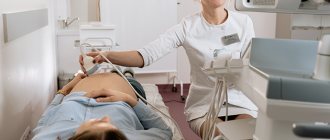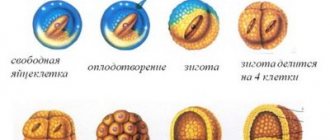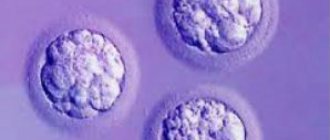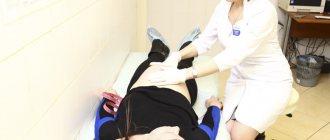Stitching pain in the lower abdomen during pregnancy can be caused by normal physiological processes, or may indicate the development of pathology. It is quite difficult to understand whether the sensations are normal or not, so the occurrence of pain should be reported to the doctor monitoring the pregnancy.
You should pay attention not only to the localization of pain and its intensity, but also to the accompanying symptoms. If the stabbing pain does not go away within several hours or the general condition worsens, then you should urgently seek medical help.
Why does stabbing pain occur?
Pain in the abdomen can also occur during a normal pregnancy, since the enlarging uterus puts pressure on neighboring organs, the ligaments that support it are stretched, and progesterone relaxes the intestinal muscles, which leads to atony and impaired digestive function. Mild short-term pulling or tingling pain in the lower abdomen is not considered a symptom of pathology.
You can eliminate it by drinking an antispasmodic (Drotaverine, No-shpa), taking a warm bath or massaging your lower back. Stitching pain caused by the growth of the uterus can accompany the entire gestation period. By the end of the first trimester, the size of the uterus is large enough to affect the position of other organs. And by the 38th week of pregnancy, the fundus of the uterus is located at the tenth rib and the xiphoid process, which leads to a displacement of all abdominal organs.
The liver moves slightly sideways and upwards, so a woman may have a disruption in the outflow of bile, and this provokes an increase in pressure in the gland and the occurrence of periodic colic. The ligaments that support the uterus are stretched, and this causes pain in the lower abdomen, which becomes more pronounced with bending over and physical activity.
No ads 1
The ligaments receive a greater load in the period from 15 to 21 weeks of gestation, since the uterus is already quite large and has not yet descended onto the pelvic bones. For the normal passage of the child through the birth canal, the pubic symphysis diverges, which also causes pain. Hormones that are necessary to relax the muscles of the uterus also affect the functioning of the intestines.
As a result of impaired digestion, the processes of fermentation and putrefaction intensify, gas formation increases, which can also lead to stabbing pain. Lack of bowel movements for 2-3 days can cause muscle spasms, stabbing and pressing pain in the abdomen, and nausea. Due to irritation of the nerve plexuses of the large intestine, spastic contractions of the wall of the colon and bladder occur, which is felt as a painful false urge to empty the bowel or bladder.
At 6–7 weeks of pregnancy, the embryo implants into the uterine wall. This process can cause stabbing or aching pain in the lower abdomen.
Colic, caused by physiological processes, occurs abruptly and passes quickly. Most often they are felt when a woman remains in one position for a long time. Severe stabbing pain occurs if the child hits internal organs during movement. Such pain does not increase, but gradually declines.
Sharp abdominal pain at 38–39 weeks of gestation can be the onset of labor, and contractions do not always coincide with the release of the mucous plug or water. You can distinguish the onset of labor from pathology by an increase in pain and a decrease in the intervals between attacks.
Diseases of the hepatobiliary system
Since during the period of bearing a child a woman’s body experiences severe stress, and all its systems undergo a number of changes, the likelihood of developing certain pathologies increases during pregnancy. In addition, decreased immunity leads to exacerbation of chronic diseases.
Progesterone relaxes the ducts of the gallbladder, which, starting from the first trimester of pregnancy, leads to insufficient emptying and stagnation of bile. Impaired excretion of bile leads to the development of dyskinesia, acute or chronic cholecystitis, which is manifested by pain in the right hypochondrium, radiating to the right scapula, shoulder and collarbone, nausea, vomiting, belching, and a bitter taste in the mouth.
During pregnancy, the risk of stone formation in the liver, kidneys and gall bladder increases, as water-salt metabolism is disrupted. The lithogenicity of bile increases under the influence of estrogens, the concentration of which gradually increases during gestation, since hormones inhibit the synthesis of chenodeoxycholic acid, which promotes the dissolution of cholesterol.
Causes of cholelithiasis also include eating large amounts of sweets and fatty foods, excess body weight, impaired motility of the biliary tract, displacement of the gallbladder, and changes in diet.
Gallstone disease in pregnant women may be asymptomatic
If cholelithiasis was diagnosed before pregnancy, then in 45% of cases during gestation the disease manifests itself clinically. In mild form, it manifests itself as heaviness in the right hypochondrium, bitterness in the mouth, heartburn, a tendency to constipation or diarrhea, and is often regarded by women as early toxicosis. In some cases, the disease may manifest itself as periodic jaundice of the skin and sclera, short-term darkening of urine and lightening of stool.
In 88% of pregnant women who have manifested the disease, attacks of biliary colic appear, which are characterized by severe pain in the epigastrium or right hypochondrium radiating to the right half of the body, nausea, vomiting with bile that does not provide relief, heartburn, bitter belching, bloating and distension in the abdomen . Colic can be triggered by active movement of the child, poor diet, physical activity, stress, and infectious diseases.
Inflammation of the appendix
The most common surgical pathology in pregnant women is inflammation of the appendix. Moreover, the pathology occurs somewhat more often in pregnant women than in non-pregnant women and is detected already in late destructive stages. Up to 19–32% of cases of appendicitis occur in the first trimester, 44–66% in the 2nd trimester, and 15–16% in the third trimester of pregnancy.
Inflammation of the appendix occurs due to the activation of microflora living in the intestinal lumen. During pregnancy, there are additional factors that contribute to the development of pathology:
Why does the lower abdomen and lower back hurt during pregnancy?
- displacement of the cecum and appendix. The large intestine is displaced upward and outward by the uterus, which can lead to kinking of the appendix, its stretching, disruption of blood supply and emptying, and the atypical location prevents the formation of adhesions, so there is no protective limitation of inflammation;
- delayed bowel movement. With constipation, the contents of the appendix stagnate and the pathogenicity of the intestinal flora in it increases;
- decrease in hydrochloric acid concentration. If before pregnancy a woman suffered from hypoacid gastritis, then during pregnancy the disease worsens and gastric juice does not perform a protective function, which leads to the growth of pathogenic microflora;
- immunity disorder. When carrying a child, a relative physiological immunodeficiency occurs, which is necessary to protect the fetus from rejection. In addition, some of the antibodies are used to provide the baby with humoral immunity.
Pregnant women later seek medical help, since the symptoms of catarrhal appendicitis can be attributed to toxicosis. In the first trimester, the clinic includes cutting or stabbing pain on the right in the iliac region, which radiates to the lower abdomen or lower back, nausea, vomiting, single diarrhea, flatulence, fever, tension in the abdominal muscles.
In the 2nd and 3rd trimester, the appendix moves, it hurts in an atypical place, usually in the right side closer to the ribs, and the enlarged abdomen makes it difficult to detect tense abdominal muscles. Appendicitis develops quickly: phlegmonous inflammation occurs within 6–24 hours, and gangrenous inflammation within 24–72 hours.
Appendicitis occurs faster during pregnancy because the organ is located atypically and the immune system is compromised.
Intestinal obstruction
Another pathology that requires surgical intervention and is manifested by stabbing pain on the left or right is intestinal obstruction or ileus. The disease develops as a result of mechanical compression of the intestines, which stops or disrupts the movement of feces and accumulates gases. Ileus occurs as a result of increased pressure of the uterus on the intestine and stagnation of feces.
Pathology most often develops in the second or third trimester. A characteristic symptom of developing obstruction is stabbing or bursting pain in the abdomen, which appears suddenly and occurs in paroxysms (repeated at regular intervals). The disease is also indicated by the absence of bowel movements, gas retention, abdominal asymmetry, fecal vomiting, and nausea.
The disease develops rapidly and the patient should receive medical care within a few hours after the clinic appears.
Ulcerative colitis
Chronic inflammation of the large intestine is called ulcerative colitis. The disease can develop against the background of autoimmune disorders, genetic predisposition, and infectious processes. Symptoms of ulcerative pathology are:
- persistent stabbing pain in the lower abdomen, intensifying a couple of hours after eating;
- stool disorder. Constipation occurs, followed by diarrhea. The stool is mushy, with pus and blood visible in it;
- painful false urge to defecate;
- intoxication syndrome (headache, weakness, muscle pain, lethargy, decreased performance);
- temperature rise to febrile levels;
- lack of appetite.
Stitching pain in the abdomen can also appear as a result of gynecological pathologies, for example, ectopic pregnancy, miscarriage, isthmic-cervical insufficiency. The severity of the disease is indicated by bloody discharge from the genitals, increased temperature, increased intensity of pain during bowel movements or urination, pallor, and a sharp decrease in blood pressure. At 38 weeks of pregnancy, contractions become more frequent and become more painful.
Tingling in pregnant women
According to statistics, the feeling of tingling in the uterus during pregnancy is not uncommon: every third woman reports such symptoms to doctors from the first weeks after conception. This is natural, since conception means a global restructuring of a woman’s entire body, which includes the growth of the uterus, which causes various sensations in the corresponding area of the abdomen.
However, there are also not so natural and harmless reasons that cause pain in the lower abdomen, and the woman herself cannot distinguish normal from pathology, especially during her first pregnancy. Therefore, it is strongly recommended that if you experience any unpleasant and/or painful sensations, consult a gynecologist, who will determine what causes these symptoms and, if necessary, prescribe treatment.
Conventionally, all sensations and tingling sensations in the lower abdomen during pregnancy can be divided into two categories:
- natural and safe;
- unnatural and requiring the attention of a doctor.
In order not to panic for any reason, you should remember that pregnancy means a huge physiological change for a woman, and the sensations do not have to be pleasant at all. This is especially true for such an important organ for pregnancy as the uterus - after all, it is there that the fetus is born, grows and develops throughout pregnancy.
Minor tingling and pulling sensations in the lower abdomen after the first month of pregnancy are completely normal phenomena that you should not be afraid of. After all, it is from this moment that the embryo begins to turn into a baby - the active growth of the fetus begins and, as a consequence, the growth of the uterus, which grows along with the fetus. But the growth of the uterus cannot occur on its own, because all organs of the human body are interconnected. So, when the uterus begins to grow, the ligaments that hold it begin to stretch, and this causes pulling sensations and mild short-term tingling sensations. Also, rapid growth of the uterus and sprained ligaments can lead to pain in the side - the body responds with pain to sudden movements. If you are not careful, you can provoke a miscarriage, so ordinary physical exercises are not recommended for a pregnant woman, but there are our own complexes that allow you to maintain physical tone, but are safe for the fetus.
Pregnant women claim that tingling in the uterus is most often felt in the evening and at night, but this is not entirely true. It’s just that at this time a woman is usually not busy with anything, resting, her body relaxes, and various sensations are immediately recorded, since they are not obscured by any events.
We recommend reading: HIV during pregnancy, Leukocytes in a smear during pregnancy, Polyps during pregnancy
When women describe a tingling sensation in the uterus, they usually say that it is like being lightly pricked with a needle above the pubis, and then this prick is felt in the groin area. Something similar is felt during egg implantation.
Unnatural tingling sensations in the uterus are:
- sharp stabbing pain;
- bloody and dark discharge, accompanied by sharp pain or without it;
- severe cramps combined with aching pain (the pain is not necessarily severe - it is similar to the pain before menstruation);
- the presence of severe discomfort during tingling.
If you experience such sensations, you should consult a doctor as soon as possible to prevent a threat to the fetus, and in some cases, to the mother.
What to do
If a stabbing pain is felt, then first of all the pregnant woman needs to relax and calm down, change her body position. If possible, you should lie down or massage your lower back. If even after rest the discomfort continues, but there are no other symptoms of pathology (discharge, fever, weakness, dizziness, nausea or vomiting), then you can take a medicine that relieves vasospasm (Drotaverine, No-Shpa) or take a warm shower.
If the pain increases, or additional signs of pathology appear, then you need to seek medical help. If vomiting, nausea, stool problems, or fever occur, you should call an ambulance. In order not to blur the clinical picture, you should not take antispasmodics or painkillers, drink or eat until examined by a doctor.
In women suffering from constipation and decreased peristalsis, the risk of developing pathology during pregnancy is several times higher
In case of hepatic or biliary colic, the pain will be somewhat reduced by a warm heating pad; if the pain is caused by cholecystitis, then cold should be applied. If the lower abdomen hurts from time to time, then you need to understand what causes the pain. The cause may be stress, errors in diet, consumption of foods that increase gas formation, or staying in one position for a long time.
In any case, any unpleasant sensations should be reported to the doctor observing the pregnancy. After the necessary research, pathology will be excluded, and the expectant mother will stop worrying. To minimize the likelihood of abdominal pain, a pregnant woman should eat right, drink enough fluids, spend plenty of time outdoors and lead a moderately active lifestyle.
Bloody discharge as one of the first signs of pregnancy
At the very beginning of pregnancy, spotting may be observed - slight bleeding, a few dark spots, a yellowish trace. Such discharge does not cause any concern and is usually taken as the beginning of menstruation. However, in fact, this is one of the first signs of pregnancy – implantation bleeding.
Implantation bleeding is associated with the implantation of the embryo on the uterine wall and can begin a week or two after conception. The discharge may be one-time, or it may appear later, which signals the implantation of the fertilized egg into the uterine wall. Such discharge is quite thick - like cream, yellow or pink.
However, if such discharge appears, you should consult a doctor, since this is not necessarily implantation bleeding, indicating pregnancy, but it is also possible that there is increased erosion of the cervix, again as a result of pregnancy, in which case medical intervention may be required.
It should be noted that implantation bleeding does not happen in 100% of cases, so the beginning of pregnancy can be completely avoided.
Shooting and swelling
The initial stage of pregnancy is also characterized by mild pain and/or shooting in the lumbar region and/or sacrum. These pains can persist throughout pregnancy, almost until childbirth. Shooting from the pelvis to the legs can also signal the onset of pregnancy.
An increased level of progesterone leads to salt retention in the body, which, in turn, leads to fluid retention. The consequence of this is swelling of varying degrees of severity, but in the early stages of pregnancy they are usually small - if you clench your fingers into a fist, you feel that the fingers seem to have gotten thicker, the rings become too small, and when you press your finger on the shin, a mark may remain that quickly passes.
Swelling can accompany a pregnant woman until childbirth. Moreover, swelling may increase. It happens that swelling appears against the background of severe toxicosis of pregnancy in the second or third trimester, and is so strong that it is simply impossible to clench your fingers into a fist - they become so swollen. It also becomes difficult to wear tight shoes - your feet swell. In case of such toxicosis, you should immediately consult a doctor.
The first trimester of pregnancy is also characterized by headaches, and they are considered an indirect sign of pregnancy. This condition is associated with a sharp hormonal jump, in fact, a hormonal shock, to which a pregnant woman is exposed almost immediately after conception, but by the end of the first trimester, the hormonal levels normalize, and headaches stop tormenting the pregnant woman.
Increased appetite
At the beginning of pregnancy, many women's appetite increases significantly. It happens that some people literally cannot leave the refrigerator while there is at least something edible left in it. Often you are drawn to certain foods, but it happens that the “zhor” is simply all-encompassing - treat all foods at once, as long as they are edible. This increase in appetite is considered one of the indirect signs of pregnancy. This phenomenon is associated with changes in hormonal levels, which stimulates appetite. Subsequently, when hormonal levels return to normal, appetite also normalizes, but addiction to certain foods may persist - the body instinctively chooses what it lacks.
Menstrual irregularities
Menstrual irregularities are a sign of pregnancy, which almost all women consider the most true and significant. A missed period is usually the reason a woman takes a pregnancy test. However, menstrual irregularities may not be associated with pregnancy; there are enough diseases and pathologies that can lead to this phenomenon. But with an active sexual life, the first and most likely explanation is still pregnancy. So the use of the test is quite justified. And most often it gives a positive result.
Vaginal discharge, thrush
When pregnancy occurs, secretions begin to be released from the vagina - this is considered one of the early signs of conception. This phenomenon is due to an increase in blood supply to the pelvic organs. At the same time, the secret amount of hydrogen ions increases, designed to protect the pregnant woman’s body from various pathogens. Unfortunately, this phenomenon also has an unpleasant downside: such an environment is beneficial for the proliferation of yeast fungi, which causes thrush in pregnant women, and this can lead to the spread of infection to the fetus, as well as to an increased susceptibility to ruptures of the tissues of the birth canal . Therefore, at the first sign of thrush, you should consult a doctor.
Tingling in the uterus
After the first week after conception, tingling sensations in the lower abdomen may appear - signs of an enlarged uterus, growing simultaneously with the growth of the fetus. Basically, such sensations are completely normal, but in some cases a doctor’s examination is required: if the painful sensations do not go away after a short rest or change of position, if they last more than an hour, if they are accompanied by bleeding, and so on.
Heaviness in the pelvic area
An increase in blood flow in the pelvic area and a gradual enlargement of the uterus leads to the fact that many women, when pregnancy occurs, begin to feel some heaviness in the pelvic area, as well as a “feeling of fullness,” and consider such sensations to be the first signs of pregnancy, especially since they can appear literally in the first days after conception.
However, an increase in blood flow in the pelvis in combination with the constantly increasing pressure of the fetus also leads to unpleasant consequences: hemorrhoids appear, which can cause very painful sensations, even when they do not burst. It happens that hemorrhoids appear almost from the very beginning of pregnancy, especially if this is not the first pregnancy.
Breast swelling
Almost all women, after a week after conception, begin to swell their breasts, their breasts become hypersensitive, and often hurt so much that any touch causes severe discomfort. There are exceptions when during pregnancy a woman does not experience the slightest discomfort associated with increased sensitivity or swelling of the breasts. It even happens that in women whose breasts are a little sore and swollen before menstruation, they suddenly stop hurting and swelling, which signals pregnancy.
Another sign of pregnancy is that the skin around the nipples becomes darker in color.
Flatulence, bloating, intestinal problems
Often, when pregnancy occurs, a woman feels that her stomach is bloated, while the enlargement of the uterus is still insignificant and cannot lead to such sensations. The feeling of an enlarged abdomen is usually provoked by the condition of the intestines - increased gas formation leads to bloating, as well as flatulence. The fact is that during pregnancy, the intestines work more slowly than usual, peristalsis is slowed down, as a result, the contents of the intestines move more slowly, constipation occurs, the stomach bloats, and a large amount of gastric gases are produced. The root cause is the same hormonal changes in the entire body, in which the vessels of the abdominal cavity fill with blood more than usual, the consequence of which is swelling of the intestinal walls with all the unpleasant consequences, ranging from flatulence and constipation to bloating.
One of the initial signs of conception that has occurred includes frequent urination - a pregnant woman can run to the toilet both day and night, and this happens much more often than usual, portions of urine can be either normal or significantly reduced. At the same time, frequent urination is not accompanied by any unpleasant sensations, characteristic, for example, of cystitis - with inflammation of the bladder, frequent urination also occurs, but it is painful, accompanied by pain and burning. Around the fourth month of pregnancy, urination frequency returns to normal. This phenomenon is also associated with changes in hormonal levels, as well as intestinal problems. An increase in the level of female sex hormones ensures increased blood flow to the vessels leading to the pelvic organs. As a result, the functioning of the organs responsible for removing urine from the body—the kidneys, ureters, and bladder—changes.
Increase and decrease in basal temperature during pregnancy
For one day in the second phase there is a sharp decrease in basal temperature. This phenomenon is called implantation retraction and is considered one of the symptoms of pregnancy. This temperature difference is associated with two hormonal shifts: from the middle of the second phase, the production of progesterone decreases, and it is this that is responsible for the rise in temperature, then, with the onset of pregnancy, the body begins to produce progesterone again, and the temperature rises, in addition, the onset of pregnancy is marked by the release of estrogen, which leads to a sharp decrease in basal temperature. As a result, a dip appears on the basal temperature chart—implantation depression. At the same time, during a developing pregnancy, the basal temperature for the first few weeks remains at 37ºC.
An increase in basal temperature in the first few weeks of pregnancy leads to a deterioration in health, fatigue increases, and the general condition resembles the onset of a cold. It should be noted that at the beginning of pregnancy, real colds are not uncommon, since at this time immunity is somewhat reduced, and catching a cold becomes easier than ever. In this case, you need to be especially careful when choosing medications, or better yet, consult a doctor, since not all medications can be used safely for the fetus.









